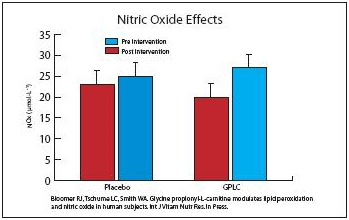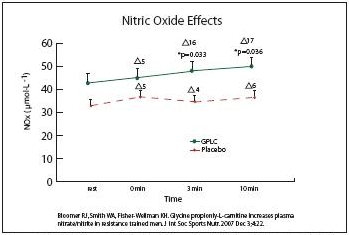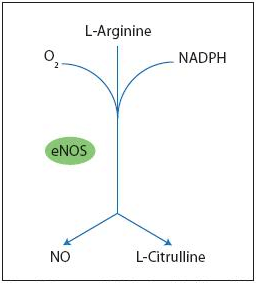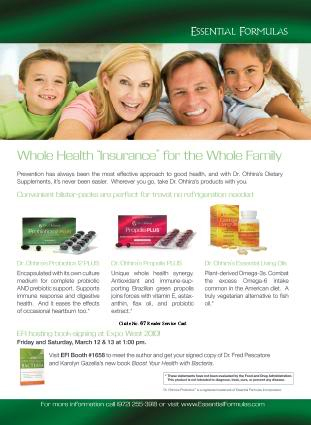 We have discussed the importance of the “advanced” carnitine called GPLC (GlycoCarn, from Sigma-tau HealthScience, Inc.) in previous columns with both cardiologist Stephen Sinatra, M.D., and exercise physiologist, Richard J. Bloomer, Ph.D.
We have discussed the importance of the “advanced” carnitine called GPLC (GlycoCarn, from Sigma-tau HealthScience, Inc.) in previous columns with both cardiologist Stephen Sinatra, M.D., and exercise physiologist, Richard J. Bloomer, Ph.D.
Dr. Sinatra discussed why GPLC is so important to the heart and artery linings. GPLC helps the heart “burn” fats for energy and maintain production of nitric oxide (NO) in the arteries to maintain proper artery function.
Previously, Dr. Bloomer discussed why these same functions of GPLC are important to high-performance sports. In the February 2008 column, Dr. Bloomer discussed his seminal research with GPLC and NO. It is important to keep in mind that GPLC is a well-tested dietary supplement that helps to optimize an athlete’s performance and health in an ethical, safe manner. GPLC is in no way an unethical or unsafe dietary supplement, and is certainly not a drug that artificially stimulates muscle growth or performance. Since then, the sports world has benefited from Dr. Bloomer’s research and it’s time to check back with Dr. Bloomer for an update.
 Dr. Bloomer has been involved with athletics since an early age and played both organized and unorganized baseball, football and hockey through high school, as well as intramurals in college. He began weight training regularly around the age of 14 and started training for bodybuilding once he reached college.
Dr. Bloomer has been involved with athletics since an early age and played both organized and unorganized baseball, football and hockey through high school, as well as intramurals in college. He began weight training regularly around the age of 14 and started training for bodybuilding once he reached college.
Following his undergraduate work, he completed his master’s degree in exercise physiology, with his thesis research focused on the impact of the macronutrient ratio and composition on the endocrine response following resistance training. After graduate school, he was a research physiologist at Duke University Medical Center for a few years, working primarily with patients that had cardiovascular disease, on which nutrition certainly plays a role. Following this work, he completed his doctorate in exercise physiology with a research focus on antioxidants and oxidative stress, in particular as they relate to exercise. He was at Wake Forest University for a year before coming to the University of Memphis, where he has been since 2004.
In his present position, he directs the Cardiorespiratory/Metabolic Laboratory, where his research is centered on nutritional supplements and oxidative stress, in particular the role of antioxidant nutrients to decrease oxidative stress, and clinical and performance outcomes related to the interaction between the two.
Passwater: Dr. Bloomer, what parameters do you use in measuring exercise performance? What is the science of exercise physiology all about?
Bloomer: We use a variety of laboratory measures to assess the effectiveness of a given nutritional supplement. For performance, these measures include muscular strength, power and endurance, in addition to cardiorespiratory power (VO2max), endurance and lactate threshold. The former assessments typically use bodyweight, free weight or machine type tests (equipped with computerized testing devices), while the latter assessments routinely involve treadmill or cycle tests using expired gas collection via a metabolic measuring system, with the addition of blood monitoring as needed.
Passwater: You referred to VO2max. This is a term that we often see, but since few of our readers are exercise physiologists, please allow me to explain this in lay terms. Basically, VO2max is the exercise physiologist’s shorthand for maximal oxygen consumption or roughly, “aerobic capacity.” It is the maximum capacity of an athlete’s body to transport and utilize oxygen during incremental exercise, which reflects the physical fitness of an athlete.
Bloomer: Basically, that’s it. In addition to the lactate threshold, VO2max is useful for comparing the aerobic capacity and performance ability of endurance sports athletes. Exercise physiology is one aspect of “exercise science” that focuses on the physiologic responses and adaptations within the multiple systems of the body (e.g., muscular, neural, skeletal, endocrine and cardiorespiratory) with an exercise intervention (either acute or chronic). As with medicine, there exist multiple sub-specialties within the broad field of exercise physiology.
Passwater: We have discussed the importance of nitric oxide (NO) in this column many times over the years, starting with Pycnogenol in the mid- 1990s. NO has become familiar to many people in terms of artery function and even to serious body builders in terms of bloodflow and muscle growth. In our previous chat, we discussed your important findings about GPLC and NO that were published in your two then most recent research publications in The International Journal for Vitamin and Nutrition Research (nitrate/nitrite and antioxidant data) and The Journal of the International Society of Sport Nutrition (nitrate/nitrite data). I want to follow up to see where these studies have led you, but first, I wish to review a few of the basics for our readers.
What is NO and what is its importance to athletes?
Bloomer: NO is an important “signaling molecule” that is associated with multiple functions in the body. The one that appears of most interest to the sports nutrition world is that of promoting vasodilation (i.e., the relaxation of smooth muscle surrounding blood vessels). The theory is that with vasodilation of blood vessels, blood flow to active and recovering muscle would be increased, leading to improved physical performance and improved post-exercise recovery.
Passwater: It is interesting that a simple gas, NO, which was basically overlooked in our bodies until the 1980s, is such an important signaling molecule. In 1992, NO was selected as “molecule of the year” by Science magazine and the scientists who elucidated its role in the cardiovascular system were awarded the Nobel Prize for Medicine. These days, I am finding that another simple gas, hydrogen sulfide (H2S), is also an important gas molecule that has been overlooked until very recently. The understanding of the role of H2S is making huge contributions to the emerging field of redox compartments in the cell. Both NO and H2S were overlooked for so long because they were simple gases and thought to be merely contaminants or unimportant by-products of reactions.
What does NO have to do with GPLC? What is GPLC and how is it involved with NO?
 Bloomer: We have reported in two separate studies that GPLC results in an increase in blood levels of nitrate/nitrite (metabolites of NO). Figures 1 and 2 summarize our findings. Therefore, supplementation with GPLC may lead to an increase in NO in some individuals. That is, not all individuals may respond to treatment. We have noted that some are “responders” and some are “non-responders.” The same is true for most, if not all, nutritional supplements, despite what some companies lead consumers to believe in their hyped-up ads.
Bloomer: We have reported in two separate studies that GPLC results in an increase in blood levels of nitrate/nitrite (metabolites of NO). Figures 1 and 2 summarize our findings. Therefore, supplementation with GPLC may lead to an increase in NO in some individuals. That is, not all individuals may respond to treatment. We have noted that some are “responders” and some are “non-responders.” The same is true for most, if not all, nutritional supplements, despite what some companies lead consumers to believe in their hyped-up ads.
Passwater: Have other studies confirmed your earlier findings?
 Bloomer: To my knowledge, no other studies have been done with GPLC in relation to NO. However, we recently completed a third study with GPLC focused on NO. Results should be available this year.
Bloomer: To my knowledge, no other studies have been done with GPLC in relation to NO. However, we recently completed a third study with GPLC focused on NO. Results should be available this year.
Passwater: Please let us know when these results are available. Now, if NO is so important to sports performance, how can an athlete safely optimize his/her NO production? How is it produced in the body?
Bloomer: First, I am not certain that the increase in NO will directly relate to an improvement in performance. This is the theory put forth by the sport supplement world and what has fueled the incredible sales of “NO stimulating” products. But, I have yet to see any scientific evidence that supports the idea that if NO increases, performance also improves. Those studies still need to be done. We are doing this work in our latest study.
That being said, we know that regular exercise training is known to increase NO. So, anyone interested in increasing NO should be training hard on a regular basis. NO is produced using the amino acid L-arginine, oxygen and a variety of other cofactors. It needs the enzyme family known as nitric oxide synthases (NOS). The NOS family member that is present in artery lining and thus is responsible for the relaxation of the arteries that allows increased blood flow is called endothelium nitric oxide synthase (eNOS). To my knowledge, the studies demonstrating a vascular benefit with oral intake of L-arginine have included small sample sizes and patients with known disease. For example, one study involving six hypertensive type II diabetics who received L-arginine at a dosage of three grams per hour over a 10 hour period (30 grams total) noted a decrease in systolic and diastolic blood pressure and an increase in citrulline (1). Another study involving eight patients with interstitial cystitis noted an increase in urinary levels of NOS related enzymes and product following daily intake of 1.5 grams of L-arginine (2).
While these data may be of interest to clinicians following such patients, in regards to younger and healthy individuals, supplementing additional L-arginine has not been shown to increase NO, despite the fact that most NO-stimulating products on the market use L-arginine as the chief ingredient. At this time, there is absolutely no evidence that any of these finished products taken orally result in an increase in NO. It’s simply strong marketing and industry hype, not scientific evidence of utility for sports performance.
Passwater: Gee, I see several products out there dealing with NO both in the sports nutrition arena and cardiac area, and most contain arginine as their “source” of NO. What I have seen in the scientific literature is a study directly comparing intravenous and oral L-arginine indicating no effect of oral L-arginine on vasodilatation, possibly attributed to variance in oral L-arginine bioavailability (3).
Additionally, I find studies involving oral intake of L-arginine at dosages from 10-20 grams indicate no benefit with regards to increasing the circulation of NO or enhancing blood flow (4-6). Logic suggests that if 10-20 grams of oral L-arginine fails to provide a favorable effect for blood NO and vasodilation, three grams is not going to get the job done! Two recent investigations support this point. One study used three grams per day of L-arginine and found no increase in NO availability, and actually noted a reduction in exercise time to fatigue in a sample of patients with peripheral arterial disease (7).
Another recent investigation involved supplementation with six grams per day of L-arginine in trained men, with the researchers concluding that “short-term arginine supplementation had no effect on NO production, lactate and ammonia metabolism and performance in intermittent anaerobic exercise” (8).
Are you saying that such products do not actually increase NO? If so, what would you suggest as being the most efficient combination of nutrients to improve NO?
Bloomer: Again, I have seen no evidence that oral L-arginine improves NO or blood flow in healthy people. The rationale for using L-arginine in these products comes from research using intravenous L-arginine at relatively high dosages (e.g., 20 grams). When doing this, blood flow has been shown to improve in some studies. But, this is far different than putting three to five grams of L-arginine into the gut. A consumer should not expect the same outcome. Only further research will identify which other nutrients besides GPLC can be used to increase NO.
Passwater: We often see such “logical” assumptions that are made from apparently “obvious” bits of incomplete information. Over-simplistic assumptions, such as eating cholesterol automatically produces cholesterol deposits in arteries, is a classic example. Then, we see some products based on animal studies that just do not produce comparable results in humans, at least not in the doses recommended. One such energy drink is an example. While laboratory rodent studies were impressive, studies in trained and untrained humans found either no improvement in energy or trivial improvement at the dosages recommend. More study is required and less hype.
Science is about measurement and we can’t assume anything. We test a variable and measure the result, if any. If there is ever a peer-reviewed, human study showing that oral supplementation with L-arginine improves performance, I want to know about it as soon as possible.
The relationship that you are describing seems to be the basic biochemical relationship between a substrate (the substance acted upon by an enzyme) and an enzyme that acts on the substrate to form a product (new compound). When there is excess enzyme, then additional substrate results in significantly more product. In this unusual case, the substrate is the limiting factor. However, in the usual situation where there is an excess of the substrate, adding more substrate has essentially no additional effect, because the enzyme is now the limiting factor. In the unusual situation where there is excess enzyme, adding more of the substrate will result in significantly more product.
 In the situation with NO in our bodies, the limiting factor is usually the enzyme, NOS, not the substrate, L-arginine (see Figure 3). Therefore, adding more L-arginine to the diet will not increase the desired product formation, NO. However, infusing L-arginine in huge quantities directly into the blood, could affect product formation through the principle of the law of mass reaction.
In the situation with NO in our bodies, the limiting factor is usually the enzyme, NOS, not the substrate, L-arginine (see Figure 3). Therefore, adding more L-arginine to the diet will not increase the desired product formation, NO. However, infusing L-arginine in huge quantities directly into the blood, could affect product formation through the principle of the law of mass reaction.
Pycnogenol has been shown to have a positive effect on NOS. Evidence suggests that it influences genetic expression so as to produce (up-regulate) more eNOS. Is this the mechanism in which GPLC increases NO in the artery walls?
Bloomer: First of all, you are exactly right regarding the idea that arginine is not the limiting factor in NO biosynthesis. Rather, the enzymes (NOS) are rate limiting. This has been discussed in an excellent paper by Kurz and Harrison (9). Companies using L-arginine as the chief ingredient in their products fail to consider such data.
Please allow me to be technical for just a moment. While we are not certain of the precise mechanism of action for GPLC, the increase in NO appears to be mediated by a decrease in NADPH oxidase activation. NADPH oxidase subsequently leads to superoxide radical generation, which, in turn, can interact with NO, decrease its bioavailability, and lead to the formation of the harmful chemical known as peroxynitrite. So in maintaining NO, GPLC may also prevent peroxynitrite formation. In a similar manner as has been suggested for Pycnogenol, GPLC may increase eNOS, leading to an increase in NO production. Therefore, NO can both be maintained and further increased with GPLC treatment.
Passwater: I note that Sigma-Tau HealthScience, Inc., a division of Italy’s Sigma-Tau, S.p.A., a company that specializes in mitochondrial function science including research with the Aminocarnitines such as GlyoCarn, has funded your research work with GPLC, in addition to other studies using their ingredients.
What safety studies have they performed to assure you of safety before you started your studies?
Bloomer: They have done in-house toxicology studies on their dietary ingredients prior to our use of them within the human clinical trials.
Passwater: A prime concern of professional athletes is that dietary supplements do not produce false results in their urine tests for banned substances. What do we know about the suitability of GPLC supplements for professional athletes regarding testing?
Bloomer: To my knowledge, GPLC is a USP-grade nutritional ingredient, and is certified by Informed Choice. As stated on their Web site “INFORMED-CHOICE tests supplements and their ingredients for inadvertent contamination with substances prohibited in sport.”
Passwater: Another concern that I often address in this column is the ethics of using nutrients to optimize one’s own health and performance. Some people including many journalists—are confused about the difference between eating healthy and taking drugs such as anabolic steroids.
Creatine and GPLC are nutrients, just as proteins, vitamins and minerals are nutrients. They are not drugs. It is just as ethical to nourish your body well with dietary supplements as it is to eat protein and take vitamins. Even the Olympians were fed ample meat before competition and the famous London guards called the “Beefeaters” were nourished as well as possible. The research you do in the performance laboratory is about finding how to best nourish athletes to enable them to perform at their best.
Do you agree that optimally nourishing an athlete is ethical?
Bloomer: Of course. Everyone who works within this area of science understands this clearly. Those in the media, and unfortunately oftentimes those in the medical community, who have just a bit of knowledge on the topic believe that they are experts. Because they have the platform to disseminate this incorrect information (e.g., creatine is a steroid), the masses are confused. The simple reality is that while there indeed exist several questionable “sports” supplements, there are a handful of ingredients/products that have been shown in clinically studies to be both safe and effective. The goal is to identify these. The ironic thing is that while certain journalists and media personalities suggest that supplements are hazardous to an athlete’s health, they make no mention of the fact that many football and baseball players are grossly overweight or that many baseball players use smokeless tobacco during the games. One thing is for certain. These issues are FAR more “dangerous” to an individual’s health than the use of a given dietary supplement. Yet, no one ever talks about this.
Passwater: Do many companies fund research to support their products and the marketing behind these products?
Bloomer: Some companies do this, certainly more today than 10 years ago. So, I give credit to those companies. Funding research to support product claims appears more commonplace in the general health supplement market than it does in the sport nutrition market. Many companies do not fund research because rather than spend $50–100K on a solid research study, they would prefer to spend that same amount of money per month on advertising and hyping up their products in the mainstream bodybuilding and fitness magazines.
The simple reality is that most companies rely solely on “borrowed research” done by others and then simply are read by the company “research and development team.” These individuals assume that if they include in their product a “key” ingredient that was noted in another work to do something wonderful, then it will automatically have the same effect in users when consuming their product.
The main problem here is that the route of administration is often different (intravenous versus oral), the test “subjects” are often different (animals or cells versus humans) and the dosage of the key ingredient is often FAR less than what was used in the original study. It’s like saying that aspirin at 325 mg works great to alleviate the pain associated with a headache and then recommending that someone use 25 mg of aspirin. Yes, it’s aspirin, but at less than a tenth of the effective dosage, it will likely do nothing at all.
Companies cannot afford to include the effective dosage of all ingredients they choose to use. If they did, the product may cost $129.95 rather than $29.95. The alternative is to include just a few key ingredients at the research supported dosage and leave it at that. But, many companies want to compete with each other on the issue of “number of ingredients” contained within their product. The result is a pixie dust formula that contains a whole lot of nothing.
Passwater: Have you noted any other benefits of GPLC for athletes?
Bloomer: We have noted that GPLC has antioxidant properties and decreases the extent of oxidative damage to cellular lipids. This may have importance in relation to recovery from exercise. However, additional work needs to be done to confirm this hypothesis.
Other recently published work from Dr. Patrick Jacobs of the department of exercise science and health promotion at Florida Atlantic University and his colleagues report a significant improvement in high-intensity exercise performance with GPLC intake, as well as a significant reduction in blood lactate (10). Blood lactate can be associated with muscle fatigue, so these data have relevance in terms of sport performance. These data are the most important in relation to GPLC intake and athletic performance, as they directly relate to performance variables, unlike our prior work which simply measured bloodborne variables.
In our recently completed study, we measured a host of performance parameters, in addition to blood parameters. We also used a device to measure muscle tissue oxygen saturation, which may provide insight into the potential effect on the blood flow of GPLC. This was a very involved study and I believe it will answer some important questions regarding GPLC as an exercise aid. Again, these data will be available in 2010.
Passwater: I’m glad you mentioned the research of Dr. Jacobs. I have seen his study and we are planning a future chat for this column. So, to sum up briefly in lay terms, why should an athlete consider taking a GPLC supplement and how much is needed to be effective?
Bloomer: The quick take-home message for athletes is that GPLC may aid in increasing blood NO (as measured by the metabolites nitrate/nitrite; as supported by our work) and it is possible, although not yet confirmed, that this increase in NO may be associated with performance improvements. GPLC may also improve high-intensity exercise performance, which may be associated with a decrease in lactate accumulation (as noted by Jacobs and colleagues). Finally, GPLC may provide antioxidant benefits (as noted by our work), which may simply provide for the maintenance of overall health and possibly exercise recovery.
Passwater: In addition, users of GPLC may receive several other health benefits, especially in heart and artery function. Other than GPLC, which specific supplements might be of benefit to athletes for both overall health and performance?
Bloomer: For overall health, I believe we first need to focus on both exercise training and quality nutrition. This includes a year-round plan, not simply a few weeks pre-season and into the season—12 months for anyone who is serious and committed to making progress.
For exercise, this includes a well-structured program inclusive of both resistance and aerobic training. The amount of each would be dictated by the metabolic demands of the sport. For example, baseball is an anaerobic sport (e.g., stand around and do nothing most of the game and then sprint for a few seconds now and then). These athletes likely should be doing high-intensity work intervals and not spending a lot of time on distance running. A qualified strength and conditioning coach should be able to design an appropriate program.
For nutrition, multiple and frequent, macronutrient-balanced meals are suggested. This means five to seven smaller and balanced meals of lean protein, low-fat dairy products, micronutrient- and fiber-rich fruits and vegetables, whole grains, nuts, quality oils, etc. Meal replacement shakes can be used for some of these meals. I personally mix fruit, dry oats, yogurt and protein powder in a blender drink. It tastes great, it’s loaded with nutrients and it costs less than any “meal” you’ll buy in a fast-food restaurant. Athletes need to learn to plan their food intake, just as they do their training. Without planning, they will not be successful.
 Once the above is in order, the athlete should consider dietary supplements. In addition to a good-quality protein powder (many are great, so they simply need to shop around and find one that is of good quality and taste), the following may be considered:
Once the above is in order, the athlete should consider dietary supplements. In addition to a good-quality protein powder (many are great, so they simply need to shop around and find one that is of good quality and taste), the following may be considered:
1. Multivitamin/multimineral: This may not directly influence performance, but may be associated with maintenance of health.
2. Essential fatty acids—omegas-3 and -6: These are for overall health and reduced inflammation.
3. Antioxidants: Many are available with science to support their use; a good blend may be best, but simply the use of vitamins C and E has been reported to provide benefits in many studies.
4. Vitamin D: Many new studies support the use of vitamin D for overall human health—getting 30 minutes of sunlight per day will not get the job done, especially considering the regular use of sunscreens. Just look at the scientific evidence.
5. Carbohydrate powder: Use of carbohydrate has been shown in many studies to maintain immunity and to improve endurance performance.
6. Caffeine: All athletes may benefit from use of caffeine; non-users appear to benefit most.
7. Creatine: Primarily used to improve power performance (e.g., sprinting, jumping and weightlifting). Creatine monohydrate is very inexpensive and works great for most individuals. There is little to no evidence that other forms of creatine are better than monohydrate in terms of muscular performance and hypertrophy. Most of the creatine battles are fueled by pure hype and marketing.
8. Beta Alanine: Although not acting in a similar mechanism as creatine (it acts as a hydrogen ion buffering agent), beta alkaline is primarily used to improve power performance.
9. Betaine: Relatively new in sport nutrition, but a couple of recent studies suggest promise.
10. Essential amino acids: Only six grams consumed before resistance exercise favorably impact protein turnover during the post-exercise period; 35 grams of carbohydrate taken with the amino acids may be best.
11. Pre-workout powder: Many products are simply a container of caffeine and maltodextrin (carbohydrate), plus 50 other ingredients that do absolutely nothing at the dosage provided, but make the label look better and confuse consumers! Athletes should seek a product that contains a mix of stimulants, performance enhancing ingredients and recovery ingredients. In essence, a quality product will contain most (or all) of the nutrients indicated in numbers one through 10 above. One such product that I recently helped to develop is called Muscle Marinade from PURUS LABS. This product was developed for the serious athlete, and includes only those ingredients with human scientific evidence for effect included at the dosage used in the clinical studies. This is indeed a novelty in the pre-workout dietary supplement class and may greatly benefit athletes. In fact, all products now developed for PURUS LABS follow the same principle—thorough review and evaluation of clinical evidence and use of research-proven ingredients at the dosage used in the clinical studies. This is certainly welcome in the field of sports supplements.
12. Post-workout powder: This should contain a combination of protein and carbohydrate, in order to facilitate muscle recovery. Such a “product” is easily made at home by mixing protein powder with a quality carbohydrate source (e.g., juice, oats or fruit). Nothing fancy is needed here. Just make sure it is consumed within minutes following strenuous exercise. WF
References
- N.T. Huynh and J.A. Tayek, “Oral Arginine Reduces Systemic Blood Pressure in Type 2 Diabetes: Its Potential Role in Nitric Oxide Generation,” J. Am. Coll. Nutr. 21 (5), 422–427 (2002).
- M.A. Wheeler, et al., “Effect of Long-Term Oral L-Arginine on the Nitric Oxide Synthase Pathway in the Urine from Patients with Interstitial Cystitis,” J. Urol. 158 (6), 2045–2050 (1997).
- S.M. Bode-Böger, et al., “L-Arginine-Induced Vasodilatation in Healthy Humans: Pharmacokinetic-Pharmacodynamic Relationship,” Br. J. Clin. Pharmacol. 46 (5), 489–497 (1998).
- M.R. Adams, “Oral Arginine Inhibits Platelet Aggregation but does not Enhance Endothelium-Dependent Dilation in Healthy Young Men,” J. Amer. Col. Cardiol. 26 (4), 1054–1061 (1995).
- J.P. Chin-Dusting, “Effects of In Vivo and In Vitro L-Arginine Supplementation on Healthy Human Vessels,” J. Cardiovasc. Pharmacol. 28 (1), 158–166 (1996).
- T.M. Robinson, D.A. Sewell, and P.L. Greenhaff, “L-Arginine Ingestion after Rest and Exercise: Effects on Glucose Disposal,” Med. Sci. Sports Exerc. 35, 1309–1315 (2003).
- A.M. Wilson, et al., “L-Arginine Supplementation in Peripheral Arterial Disease: No Benefit and Possible Harm,” Circulation 116 (2), 188–195 (2007).
- T.H. Liu, et al., “No Effect of Short-Term Arginine Supplementation on Nitric Oxide Production, Metabolism and Performance in Intermittent Exercise in Athletes,” J. Nutr. Biochem. 20 (6), 462–468 (2009).
- S. Kurz and D.G. Harrison, “Insulin and the Arginine Paradox,” J. Clin. Invest. 99, 369–370 (1997).
- P.L. Jacobs et al., “Glycine Propionyl-L-Carnitine Produces Enhanced Anaerobic Work Capacity with Reduced Lactate Accumulation in Resistance Trained Males,” J. Int. Soc. Sports Nutr. 6, 9 (2009).
Dr. Richard Passwater is the author of more than 40 books and 500 articles on nutrition. He is the vice president of research and development for Solgar, Inc. Dr. Passwater has been WholeFoods Magazine’s science editor and author of this column since 1984. More information is available on his Web site, www.drpasswater.com
Published in WholeFoods Magazine, March 2010










